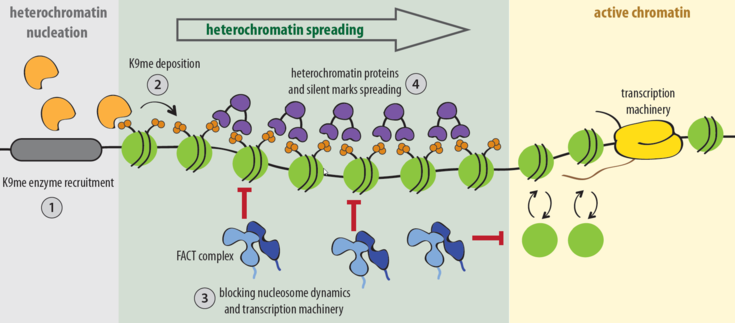Spreading the silence
An international collaboration found how cells protect silent parts of the genome from being transcribed
A central question in biology is how differentiated cells maintain their identity. Meanwhile, it is known that this is achieved through specific gene expression patterns and partitioning the genome into transcriptionally active and inactive domains. The impairment of this process leads to genome instability and cancer. Repressive chromatin domains, also called heterochromatin, consist of DNA and histones marked with ‘silent’ chemical marks. Heterochromatin establishment involves distinct steps, starting with the nucleation of those silent marks at a particular chromatin locus followed by their expansion over large genomic regions, a process also known as heterochromatin spreading. However, the cellular factors that control the spreading reaction are yet poorly understood, largely due to technical difficulties to study this process.
By applying cutting-edge singe-cell analysis, genomics and genetics in the powerful model organism fission yeast, an international team led by Magdalena Murawska now shed light on the regulation of heterochromatin spreading. A critical aspect of the study was the employment of various yeast mutants and the ability to monitor the heterochromatin spreading reaction along the chromosomal axis in single cells using a method that was recently developed in Prof. Al-Sady’s lab. Together, this led to the discovery that a highly conserved and essential histone chaperone complex, FACT, promotes the spreading of heterochromatin domains by facilitating the deposition of silent histone marks. FACT achieves this through limiting the dynamics of heterochromatic histones, which blocks the access of the transcription machinery to heterochromatic regions. Thereby, FACT protects the silent genome from being transcribed. This finding was unexpected as FACT is predominantly enriched at active domains of the genome where it has been extensively studied. Thus, this study expands the functional repertoire of the multitasking FACT complex.
FACT is often mis-expressed in various types of cancer and has emerged as a potential target for novel anticancer therapies. The study of Magdalena Murawska, Sigurd Braun and others suggests that when FACT is impaired, cells may start to lose their identity due to illegitimate transcription of the silent domains. Since loss of cellular identity is a critical early step in cancer initiation, these findings may help to better understand FACT’s role in preserving genome integrity and cellular health.
Publication: Murawska et al.: The histone chaperone FACT facilitates heterochromatin spreading by regulating histone turnover and H3K9 methylation states, Cell Reports, 2021


